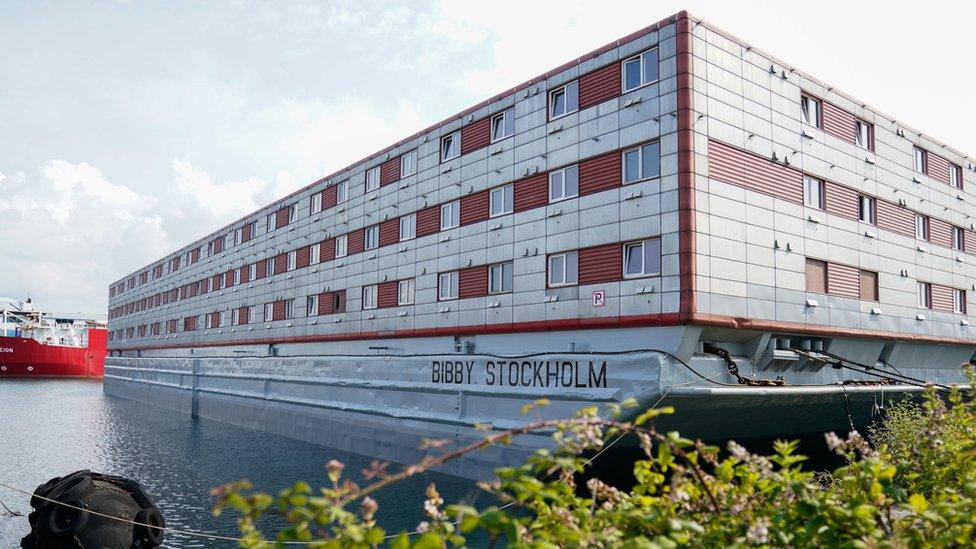Fact-checking claims about asylum seekers
- Published

Immigration Minister Robert Jenrick and Shadow Home Secretary Yvette Cooper were interviewed separately on the BBC's Today programme about government plans to tackle illegal migration.
They made claims about housing asylum seekers in hotels and barges as well as about the Rwanda scheme.
Are they right?
Are there 10,000 more asylum seekers in hotels?
Ms Cooper said there was a "10,000 increase in the number of people in hotels since Rishi Sunak promised to end hotel use six months ago".
It was on 13 December 2022 (almost eight months ago) that Mr Sunak said, external the government "must end" using hotels to house asylum seekers but did not set a date for when this is expected to happen.
It is true that the number of asylum seekers staying in UK hotels has increased since December, but not by 10,000.
At the end of December 2022, there were 45,775 asylum seekers in UK hotels according to government figures.
By the end of June 2023 - the latest available data, external - this had risen to 50,546.
This is an increase of 4,771 staying in hotels - half the number claimed by Ms Cooper.
Labour told BBC Verify that the figures were based on a home affairs committee session on 21 December when Suella Braverman said there were 'some 40,000' accommodated in hotels.
Are barges used in Belgium, the Netherlands and Scotland?
Robert Jenrick defended the government's use of the Bibby Stockholm barge to house asylum seekers.
He said: "Barges like this are used in Belgium, in the Netherlands, the Scottish government have used a similar vessel for Ukrainian refugees".
The countries Mr Jenrick mentions have all used vessels of varying types to accommodate asylum seekers.
In 2016, authorities in the city of Ghent in Belgium used a converted boat called The Reno as a temporary reception facility for asylum seekers, external. It accommodated 250 asylum seekers but closed in March 2017.
The Netherlands has used the MS Silja Europa for about 900 asylum seekers. It has a capacity of 3,000 and is one of the biggest passenger ferries in the world. There are currently 1,500 people staying on MS Galaxy, external in Amsterdam.
Scotland used cruise ships to house Ukrainian refugees. One ship was docked in Glasgow and housed 1,200 refugees, while 1,000 more lived on a ship in Edinburgh.
The refugees have all now left and moved into other accommodation.
Ukrainian refugees living on a cruise ship in Scotland have been moved into new accommodation
Will Rwanda scheme increase trafficking?
Ms Cooper criticised the government's plan to send asylum seekers to Rwanda and said: "The Israel Rwanda scheme actually ended up with an increase in trafficking".
She did not specify the destination of those being trafficked.
Under the "voluntary departure" scheme that Israel ran between 2014 and 2018, about 4,000 Eritrean and Sudanese asylum seekers - who had arrived in Israel - were sent to Rwanda and Uganda.
Evidence collected by the International Refugee Rights Initiative (IRRI), external in 2015 indicated that almost all of the asylum seekers were smuggled out of Rwanda "within days of arriving in Kigali".
Its report also claimed that people sent to Rwanda were not given an opportunity to apply for asylum there and were left without any legal status.
We have not been able to find any figures about whether the scheme led to an overall increase in trafficking.
But in June 2022, the BBC interviewed an expert on the Israeli scheme, Dr Yotam Gidron, who said that it had become a means of joining the smuggling route to Europe.
What happened to the EU scheme for returning migrants?
Mr Jenrick was asked about past schemes for returning failed asylum seekers while the UK was still in the EU.
He replied: "The Dublin arrangement which you're referring to didn't work well, in fact in their last years of operations more individuals were brought from the continent to the UK than were sent in the other direction."
The Dublin Regulation , externalis an EU scheme which allows member states to return failed asylum seekers to other EU countries, taking into consideration factors such as family reunion and irregular entry.
The scheme ended in the UK after Brexit - in January 2021.
Home Office data, external shows that more people came to the UK - under the scheme - than left in the final two years it was operating.
2019: 714 arrived in the UK and 263 left
2020: 882 arrived in the UK and 105 left

